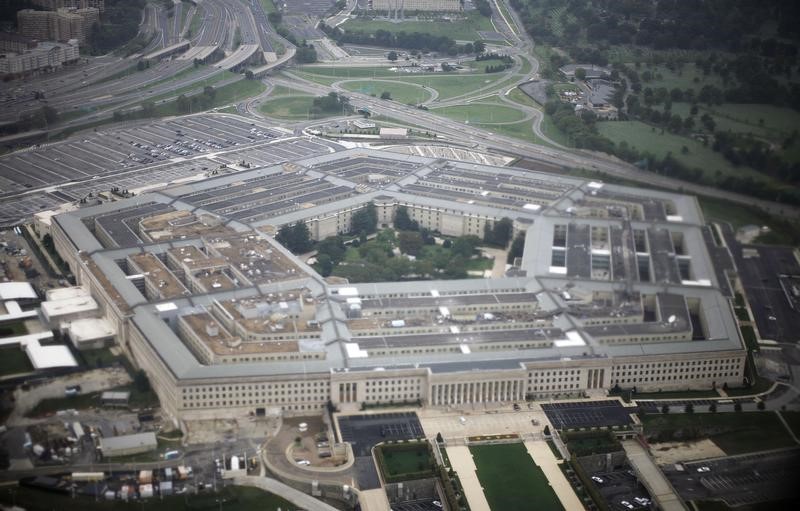Should the Defense Department take seriously the threat of climate change?

Brick by brick, the Obama administration’s climate legacy is being disassembled across the federal government.
At the Energy Department, Rick Perry has commissioned a study of the electric grid that some environmentalists see as a pretense for attacking wind and solar energy. At the Interior Department, Ryan Zinke is attempting to roll back rules meant to reduce the emissions of methane, a potent greenhouse gas. And at the Environmental Protection Agency, Scott Pruitt is trying to, among many other things, undo the linchpin of Obama’s emissions-reduction effort, the Clean Power Plan.
But there’s at least one place in Washington that is not (yet) a deconstruction site when it comes to climate change – the Pentagon.
The Department of Defense has for a long time now been quietly studying how to adapt to the effects of climate change, even prior to President Barack Obama’s election.
“The nature and pace of climate changes being observed today and the consequences projected by the consensus scientific opinion,” read a 2007 Military Advisory Board report from retired generals and admirals, “are grave and pose equally grave implications for our national security.”
[U.S. House panel wants to know how climate change impacts the military]
Among the issues researched have been how sea-level rise threatens to swamp some coastal military bases and how extreme weather may exacerbate social tension in war-prone places. The concern has been summed up in one two-word phrase in military circles – climate change is a “threat multiplier.”
Now Congress will weigh in on how far that line of thinking will continue under President Donald Trump.
In late June, the GOP-led House Armed Services Committee passed an amendment, introduced by Rep. Jim Langevin, D-R.I., to the annual defense authorization bill that directs the Defense Department to assess the vulnerabilities of the ten bases in each service most threatened by the effects of climate change. A three-foot rise in the ocean’s water could submerge 128 U.S. military installations along, one 2015 study found.
The amendment also has Congress in general acknowledging that “climate change is a direct threat to the national security of the United States.”
“The fact is that the planet is warming and there are national security implications as a result of that,” Langevin said. “We can’t just stick our head in the sand, and hope they’re going to go away.”
The amendment passed committee by voice vote and was sent to the full House. Only one Republican, Rep. Liz Cheney, R-Wyo., raised concerns during the Armed Services panel hearing.
“North Korea is not developing nuclear tipped ICBMs because the climate’s changing,” Cheney said at the hearing. “ISIS and al-Qaida are not attacking the West because of the weather.”
Other GOP members have produced counter-amendments swinging even harder at the Defense Department’s work on climate change.
Rep. Scott Perry, R-Pa., introduced an amendment to the NDAA that would simply strip out Langevin’s language in order to save the department money and keep the Pentagon focused on its “essential mission.”
“My goal with this amendment is to prioritize our limited defense resources on efforts that pose an immediate and direct threat to our national security,” Perry told the York Daily Record in his district.
But an amendment from Rep. Warren Davidson, R-Ohio, goes even further, striking down an executive order issued by Obama in 2015 that required the military, a huge consumer of energy, to meet greenhouse-emissions targets.
That proposal received the backing of a powerful coalition of 14 conservative organizations, including the Competitive Enterprise Institute, whose director Myron Ebell led the Trump transition team at the EPA.
“These climate programs and policies have nothing to do with the mission of the United States’ Armed Services,” Ebell and the other organizations’ leaders wrote in a letter to lawmakers. “In fact, many of these programs and policies are likely to undermine military readiness by diverting scarce resources to such things as helping state and local governments to ‘go green.'”
What does Defense Secretary Jim Mattis think? The retired Marine Corps general is one of the few members of Trump’s Cabinet that seems to take the threat of climate change seriously.
“Climate change is impacting stability in areas of the world where our troops are operating today,” Mattis told the Senate in written testimony after his confirmation hearing. “It is appropriate for the Combatant Commands to incorporate drivers of instability that impact the security environment in their areas into their planning.”
Based on Mattis’s past statements, John Conger, who as a former principal deputy under secretary in the Defense Department’s comptroller’s office and in other positions at the department oversaw the energy and environmental policy at bases, said that he does not expect the Pentagon to oppose Langevin’s amendment.
“It sends a message to the DoD that Congress supports Secretary Mattis’ position on climate change – echoing his previous statements in a sense of Congress,” Conger told me. “The vulnerability assessment would be valuable both for DoD as it manages its enterprise and for Congress as it conducts oversight.”
What happens next: So far, the Trump administration has not publicly objected to the climate provision in the NDAA. The White House did not include a response to the request for a climate study in a lengthy policy statement it issued on the NDAA this week.
On Wednesday, the House began consideration of the NDAA. The Senate, too, must pass its own version of the bill, and the two chambers will have to work out differences in the language.